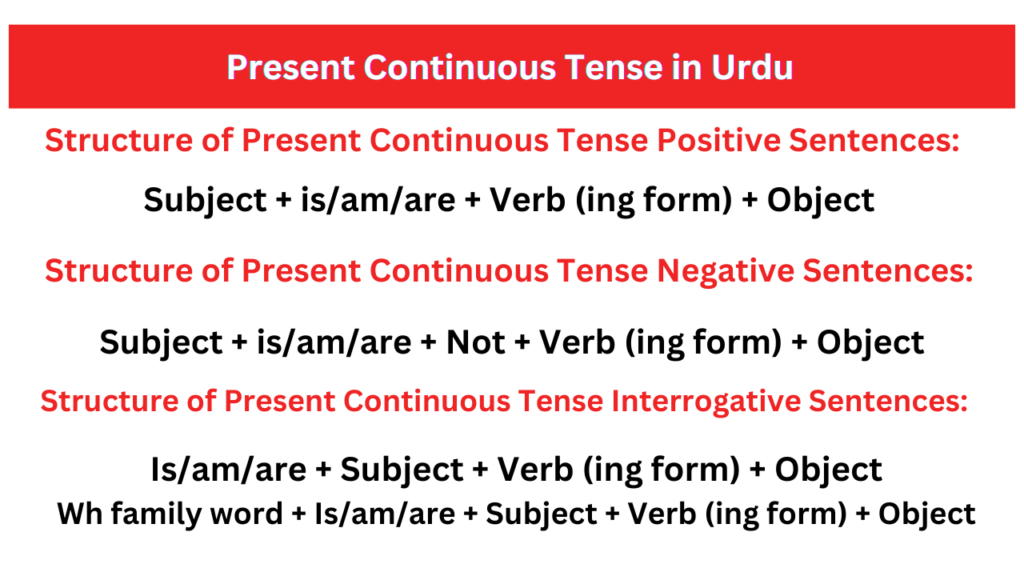Present Continuous Tense (مضارع جاری) is used to describe actions that are in progress at the moment of speaking or actions that are happening around the present time. In this post, I have explained every detail you want about the Present Continuous Tense in Urdu. Let’s dive in:
Structure:
- Subject + is/am/are + Verb (ing form) + Object
- Example: He is reading a book. → وہ کتاب پڑھ رہا ہے۔
Examples in Urdu:
- I am eating food. → میں کھانا کھا رہا ہوں۔
- She is working on a project. → وہ ایک پروجیکٹ پر کام کر رہی ہے۔
- They are playing football. → وہ فٹ بال کھیل رہے ہیں۔
- We are studying right now. → ہم ابھی مطالعہ کر رہے ہیں۔
- He is talking to his friend. → وہ اپنے دوست سے بات کر رہا ہے۔
In this tense:
- For I, we use am (میں ہوں)
- For he, she, it, we use is (وہ ہے)
- For we, you, they, we use are (ہم ہیں، آپ ہیں، وہ ہیں)

Use of Present Continuous Tense in Urdu (مضارع جاری):
The Present Continuous Tense is used to talk about:
-
Actions happening right now (at the moment of speaking).
- Example:
She is studying. → وہ پڑھ رہی ہے۔ (This means that she is studying right at this moment.)
- Example:
-
Temporary actions that are happening around the present time but not necessarily at the moment of speaking.
- Example:
He is working on a new project this week. → وہ اس ہفتے نئے پروجیکٹ پر کام کر رہا ہے۔ (This means that he is working on a project, and it’s temporary, limited to this week.)
- Example:
-
Future plans or arrangements (when we plan something or make an arrangement for the future).
- Example:
They are meeting us tomorrow. → وہ کل ہم سے مل رہے ہیں۔ (This indicates that they have a plan to meet tomorrow.)
- Example:
Structure of Present Continuous Tense:
- Affirmative Sentence (Positive):
Subject + is/am/are + Verb(ing)- Example:
I am eating. → میں کھا رہا ہوں۔
- Example:
- Negative Sentence:
Subject + is/am/are + not + Verb(ing)- Example:
She is not studying. → وہ پڑھ نہیں رہی ہے۔
- Example:
- Interrogative Sentence:
Is/am/are + Subject + Verb(ing)?- Example:
Are they playing? → کیا وہ کھیل رہے ہیں؟
- Example:
Detailed Breakdown:
-
For “I”:
We use “am” after I.
Example: I am reading a book. → میں کتاب پڑھ رہا ہوں۔ -
For “he,” “she,” “it”:
We use “is” after he, she, it.
Example: She is playing tennis. → وہ ٹینس کھیل رہی ہے۔ -
For “we,” “you,” “they”:
We use “are” after we, you, they.
Example: They are watching TV. → وہ ٹی وی دیکھ رہے ہیں۔
Examples in Urdu (with different subjects):
- I am drinking tea. → میں چائے پی رہا ہوں۔
- She is talking to her friend. → وہ اپنے دوست سے بات کر رہی ہے۔
- He is reading a newspaper. → وہ اخبار پڑھ رہا ہے۔
- We are cooking dinner. → ہم رات کا کھانا پکا رہے ہیں۔
- They are working hard these days. → وہ ان دنوں سخت محنت کر رہے ہیں۔
Exceptions and Usage:
-
State verbs (statements of being or possession): Some verbs, such as know, belong, believe, understand, and like, are not typically used in the continuous form because they refer to states rather than actions.
- Example:
I know him (not: I am knowing him).
- Example:
-
Use in the future: When referring to the future, Present Continuous is used to describe something that is planned or scheduled.
- Example:
We are traveling to Lahore next week. → ہم اگلے ہفتے لاہور جا رہے ہیں۔ (This expresses a scheduled plan for the future.)
- Example:
Common Errors in Present Continuous Tense (in Urdu):
- Using the wrong auxiliary verb (am, is, are):
- Incorrect: She am eating. → This is wrong because the auxiliary verb should be is with “she.”
- Correct: She is eating. → وہ کھا رہی ہے۔
- Omitting the verb “ing” form:
- Incorrect: He is play football. → This is wrong because “play” should be in the “ing” form.
- Correct: He is playing football. → وہ فٹ بال کھیل رہا ہے۔
To learn more, click on the links below for some useful resources:
Present Indefinite tense Exercise
Present Indefinite Tense Examples in Urdu
To watch video lectures on English Grammar, click on the link below:


